|
TRANSLATE THIS ARTICLE
Integral World: Exploring Theories of Everything
An independent forum for a critical discussion of the integral philosophy of Ken Wilber
 Barclay Powers is an author and futurist filmmaker. He earned
his Bachelor of Arts in East Asian Studies from Columbia University
and has an extensive background as an independent scholar. He has
studied Chinese, Tibetan and Indian meditation, yoga and martial arts
traditions for more than 30 years. Powers is currently releasing
multiple media projects worldwide in film and print, related to the
evolution of consciousness based on his studies with numerous
masters of ancient wisdom traditions. His most recent film, The Lost
Secret of Immortality, based on his book, won best
spiritual/religious/Christian film at the Great Lakes International Film
Festival, 2012, the Silver Palm Award at the Mexico International Film
Festival, 2012 and best spiritual documentary at the New York
International Film Festival, 2011. See his website at
www.lostsecretofimmortality.com for information on the book,
graphic novel and film. Barclay Powers is an author and futurist filmmaker. He earned
his Bachelor of Arts in East Asian Studies from Columbia University
and has an extensive background as an independent scholar. He has
studied Chinese, Tibetan and Indian meditation, yoga and martial arts
traditions for more than 30 years. Powers is currently releasing
multiple media projects worldwide in film and print, related to the
evolution of consciousness based on his studies with numerous
masters of ancient wisdom traditions. His most recent film, The Lost
Secret of Immortality, based on his book, won best
spiritual/religious/Christian film at the Great Lakes International Film
Festival, 2012, the Silver Palm Award at the Mexico International Film
Festival, 2012 and best spiritual documentary at the New York
International Film Festival, 2011. See his website at
www.lostsecretofimmortality.com for information on the book,
graphic novel and film.SEE MORE ESSAYS WRITTEN BY BARCLAY POWERS GNOSIS IN THE TWENTY-FIRST CENTURYScience and the Serpent of KnowledgeBarclay Powers“Recognize what is before your eyes and the mysteries will be revealed to you.” — The Gospel of Thomas 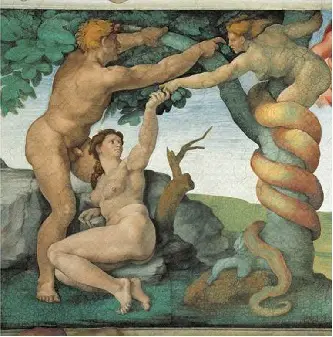 Although many outstanding scholars of religion have speculated about the actual religious experience of gnosis, and the enlightenment of prophets and sages forged by its power, a rational scientific explanation of inner illumination is only now emerging from contemplative neuroscience. Neurotheology has also shed new light on the direct experience of the Godhead and its implications for the future understanding of the evolution of consciousness, and perhaps even the rediscovery of the original esoteric meaning of the image of God within man in the 21st century. A new form of rational-magical thinking that embraces the ancient medical science of other civilizations like China and India is necessary to create a legitimate post-materialist scientific model of gnosis and the “serpent of knowledge.” A new understanding of the potential of the human reproductive system to activate dormant aspects of the central nervous system will also be necessary for modern researchers to finally lift the veil of the mystery traditions, and understand gnosis and the inner alchemical science of the imago dei underlying many ancient religions. To understand the transformation of the psyche by gnosis that many prophets and illuminated philosophers experienced, it is necessary to explore some key concepts in ancient religious mysticism. These often form a loose, repetitive narrative of the historical evolution of human consciousness as the mythologies of different civilizations conjoin and transform each other in the process of merging, and in some cases gaining dominance. In some sects, the gnostic version of the story of Adam and Eve is the union of soul and spirit (psyche and pneuma). In its complete form, pneuma is Original Mind, the pre-birth goal of meditation in East Asian systems. God, angels, demons, soul and spirit are the central characters in the theater of war between Greco-Roman and Christian mythology. At the heart of the esoteric drama is an archaic structure of consciousness within the body, the Serpent or Dragon, it's secret gift of gnosis, and the resulting union with the Godhead that results in an illuminated prophet like Jesus or Hermes Trismegistus. These religious ideas often emerge from the capacity of the human nervous system to rewire itself and emit light when fully activated by gnosis, inner alchemical meditation, and breathing exercises. 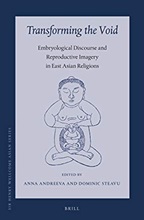
Homunculus / Spiritual Embryo
As Jung correctly noted, the Gnostics were in many cases hermetic and Christian philosophers who sought genuine inner illumination or the alchemical marriage, sometimes described as “seeing the inner image of God,” or “union with God.” The alchemical marriage of the later European hermetic tradition was anima (soul), spiritus (spirit/Dragon) and corpus (body). This conjunction of soul and Holy Spirit within the body, perfectly depicted by the ancient symbol of the ouroboros, is an actual physiological, subtle body process, not a religious fantasy or superstition. This process was also the spiritual goal of Taoist alchemical meditation in China, where the union of the soul and original spirit, Yin and Yang subtle bodies, was called the alchemical marriage of the Tiger and Dragon. The Yang subtle body, or Dragon, was the Holy Spirit or serpent of knowledge, the giver of gnosis, the full activation of the central nervous system that returns the psyche to the Garden of Eden, which is illuminated whole original consciousness. This is called pre-birth or pre-heaven consciousness in Chinese medicine, and is called the original mind in ancient Zen, which describes the direct experience of the Dragon or Holy Spirit as “Seeing your Original Face.” It is for this reason that many of the ancient prophets that experienced gnosis claimed that God had created man in his own image. They had seen the golden, original face of God with their own eyes, within themselves, in a completely uncompromised direct experience of absolute truth. Many Indian yoga traditions also describe the reality of a small golden serpent lying dormant at the base of the spine, which is believed to have the potential to fully activate the central nervous system when awakened, or unleashed. Indian medicine calls the coccygeal glomus at the tip of the spine the kundalini gland, and this may be the remnants of the primitive node or primitive streak which are created in early fetal development, as described in Western embryology. This suggests that the preformation model of embryonic development is still relevant versus the shift to epigenesis that occurred in the 20th century. The homunculus or prima materia of early Western alchemical science is the actual physiological mechanism of spiritual inner illumination within the human body. The halo, or shining countenance of the illuminated saint has been noted in many civilizations for thousands of years, along with highly evolved hands-on healing abilities which often included the skill of exorcism. Historically, many illuminated sages and alchemical philosophers were physicians and ridding the body of unclean spirits was often part of the job. The rod of Asclepius, the caduceus, the uraeus, and of course the ouroboros are all symbols of the healing/illuminating power of the serpent of knowledge. Some sects of Gnosticism and many ancient prophets and seers described the serpent as the wisest of creatures, sometimes even equating Jesus with the serpent or the divine Holy Spirit within the human body, the spark or original fragment from God.
 The Chrysopoeia of Cleopatra appears to be one of the first alchemical texts that employs the image of the ouroboros. The word chrysopoeia means gold making. In many ancient civilizations the process of creating gold using gold ore and mercury in a toxic heating process was the physical counterpart to the process of making the inner gold of the original spirit or Holy Spirit, known as the Golden Elixir or Spiritual Embryo in Chinese alchemical traditions. Chinese civilization describes itself as the “Descendants of the Dragon” and to this day a “Hidden Dragon” is a reclusive, illuminated adept who has completed a neidan (internal elixir) alchemical meditation system but does not teach openly. The other term in China for the goal of inner alchemy is the sheng tai, the spiritual or holy embryo. The difference between the orthodox Holy Spirit of conventional early Christianity, and the physiological golden androgynous Holy Spirit of esoteric alchemical gnosis has not been understood by most scholars. Nor is the kundalini a sufficient explanation, for this Indian yoga model is not the complete inner alchemical marriage still preserved in China in Taoist practice, but now lost in the West. 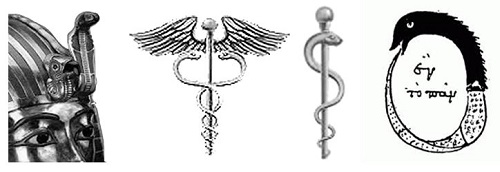 It should also be noted that the extreme solitary asceticism that often characterized the lives of ancient celibate saints, yogis and alchemists did not exclude other practices, often overlooked by scholars of Gnosticism and the mystery traditions. Since researchers have usually not been initiated in a living tradition and have had limited visionary religious experience they have generally not understood the physiological concept of the central channel that connects the reproductive and enteric nervous systems with the brain via the spine and the vagus nerve. Often in modern times, a focus on gender bias limits the study of many ancient systems that successfully created the permanent illumination of gnosis, sometimes through the use of what would now be called a form of sexual yoga. Obvious examples of this lost religious science, now in the process of rediscovery, would be Chinese medicine and inner alchemy, the Indo-Tibetan Mahamudra tradition of Karmamudra, and the androgyne/homunculus of the Western hermetic tradition, which included both spiritual alchemy and the well-known chemistry which led to modern science. Lawrence Principe at Johns Hopkins has done outstanding work in explaining the latter, although denying the validity of the former. The hermetic androgyne can in many ways be described as the occult essence of the direct experience of gnosis which is based on the physiology of the human body, as opposed to religious mythology or superstition. The probable reason that many ancient myths describe the original human being as androgynous is because the physical process of inner alchemy underlies the direct experience of gnosis. This was well known in Western Europe in terms of the hermetic androgyne or homunculus, but was lost during the Enlightenment. So to some degree the Enlightenment could actually be called the “Endarkenment.” The loss of the knowledge of the hermetic androgyne, the ancient secret of spiritual alchemy, also contributed to the loss of a living concept of the human soul in our times, occluded by the materialist world view of Western science that eventually prevailed. 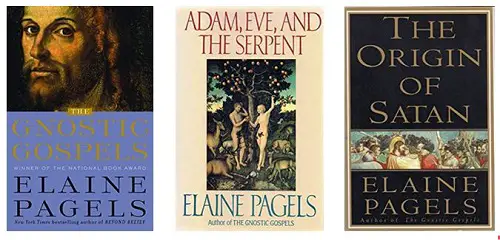 As April DeConick points out in some of her excellent studies of Valentinian gnostic sexuality, there were three basic types of sexual relations that were understood to have different meanings which ranged from lust, to family, to gnosis in the most esoteric versions. Of course celibacy was also highly prized, and celibate Gnostics and Christians were often highly critical of the idea of sexual gnosis by virtue of ignorance of its potential to rewire the nervous system and illuminate the mind. This was also true of meditating ascetics in China, India, Japan, and Tibet where there was a parallel secret tradition of spiritual sexual yoga that resulted in the experience of gnosis or physiological enlightenment. Joseph Campbell points out that the saying “Buddhahood can be found in the reproductive organs of a woman” is well-known in Tantric Buddhism. It should be noted that there was always a parallel and more conventional practice for individuals in solitary meditation. "The conjunction of the two is like the union of husband and wife, from whose embrace results golden water." — Ascanius, quoted by Edward Kelly So cross-cultural parallels are quite obvious when the physiological mechanism of gnosis is understood scientifically without materialist or religious bias. This is particularly true from an open science, post-materialist perspective that includes the medical science of other civilizations which had the goal of enlightenment or the liberation of consciousness as the highest level of their contemplative and medical traditions. Even in the West, medical science and genuine hermetic alchemy were intertwined for hundreds of years. Newton actually wrote more on alchemy than he did on physics and is sometimes considered to be the last alchemist. The fact that spiritual alchemy is usually considered to be a failed myth in the West to this day, can be considered to be one of the foremost failures of both scientism and religious studies. The first type of sexuality that the Gnostics described was the “lowest” in terms of spirituality. A drunken Roman orgy with slaves, or prostitution, would be examples of this form of sexuality that eliminated religious significance from the act. Most modern, secular, progressive, academic and scientific concepts of sexuality would essentially fall in this category of the gnostic worldview. As pointed out above, it is for this reason that most Western academics are unable to really understand the kundalini based sexuality of other cultures that have not been spiritually and intellectually castrated by Judeo-Christian based science and religion. This is particularly true of Western Taoist studies, where the understanding of the union of yin and yang subtle bodies (psyche and pneuma) within neidan alchemy is so poor that gender bias and “patriarchal injustice” sometimes becomes the main concern, versus a legitimate scientific and historical explanation and exploration of gnosis, awakening or enlightenment. The same is often unfortunately true of Indo-Tibetan Tantric studies, which have been misunderstood by the majority of Western scholars because of subjective, progressive materialist-based confusion arising from the refusal to consider any medical science with vitalist elements. The key scientific fact that enlightenment is a physiological structure of primordial consciousness within the body has also been misunderstood in modern times by contemplative neuroscience and transpersonal psychology. The second category of gnostic sexuality is procreation in a loving relationship, understanding that this is the work of God. In this case a married couple is creating children in a family together, and this represents a much more spiritual level of understanding, and is to a large extent the basis of the modern Western concept of the nuclear family. Some gnostic sects, however, even preferred celibacy within marriage, considering it to be a higher form of virtue. The third category of Valentinian gnostic sexuality, the “bride chamber” (nymphon), the most secret and esoteric, involves a specialized practice of coitus reservus that results in spiritual awakening, and would, if properly understood, represent both the Western rediscovery of the hermetic androgyne and potentially an entirely new model of embryology in medical science. This ancient science is also the original basis of Chinese medicine. The concept is that it is possible to recreate conception within the body by reversing the normal function of the reproductive and central nervous systems. This is the alchemical union of yin and yang subtle bodies (anima and spiritus). The Chinese medical system in its original form, going back to before the Yellow Emperor and the I Ching, was based on this alchemical science of reverse embryology; the yang subtle body is the Sheng Tai or Spiritual Embryo. Western scholars have only just begun to understand that many cultures that are based on a religious goal of gnosis, or inner illumination, consider the embryo to be a metaphor for awakening or enlightenment as well as physiological reproduction. The Western hermetic tradition sometimes called the Golden Embryo, which produced a true gnostic illuminated philosopher, the Infans Solaris. All of the Tathagatagarbha sutras of early Buddhism are referring to this embryo of Buddhahood/enlightenment, also known as the “Truth Body of ultimate reality.” The origin in India is probably the Hiranyagharbha, the Golden Embryo of the Vedas. Since contemplative neuroscience is now in many ways a materialist version of secular Buddhism, a unification of science and esoteric gnostic religious mysticism is already in process, though in its early stages. Gnosis, the serpent of knowledge, the primordial body of absolute truth, has the scientific potential to redefine what it means to be a human being that believes in God in the 21st Century. The Bible says that God created man in his own image, because the prophet that experienced gnosis saw the golden face of God within himself; or within herself, for there were many female alchemists and teachers. Of course the serpent has always been the wisest of creatures, which may be why it chose to reveal the secret of the Tree of the Knowledge to Eve and not Adam. In her book, Adam and Eve and the Serpent, Elaine Pagels relates that Valentinus described his realization of the embryo of enlightenment as the Logos itself, illustrating an early “heresy” pointing forward to the converging understanding of Eastern and Western medical worldviews in our own times. 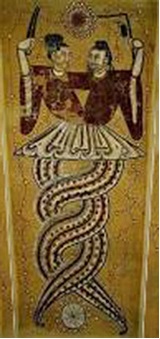
Chinese Adam and Eve, Fu Hsi and Nu Kua
Appendix: Names of the Philosophers' StoneCollected by William Gratacolle, in Five Treatises of the Philosophers' Stone, London 1652.Gold, Sol, Sun, Brasse of Philosophers, the body of Magnesia, a pure body, clean, ferment of Elixir, Masculine, Argent vive fixt, Sulphur incombustible, Sulphur red, fixed, the rubibe stone, kybrik, a man, greene vitrioll, burnt brasse, red earth: the water that is distilled from these things, is named of the Philosophers, the taile of the Dragon, a pure wind, ayre, life, lightning, the house, the afternoone light, virgin's milke, sal armoniack, sal niter, the wind of the belly, white fume, red water of sulphur, tartar, saffron, water, the white compound, stinking water, the filthiness of the dead bloud, Argent vive, a Cucurbite with his Alimbeck, the vessell of the Philosophers, a high man with a Sallet, the belly of a man in the midst, but in the end it is called the fot, or the feet, or on the which feet, or earth is calcined, rosted, congealed, distilled, or made still and quiet: the shaddow of the Sun, a dead body, a crowne overcoming a cloud, the bark of the Sea, Magnesia, black, a Dragon which eateth his tayle, the dregs of the belly, earth found on the dunghill putrefied, or in horse dung, or in soft fire, Sulphur, Mercury, secondly in number, and one in essence, name, in name, a stone, body, spirit and soule; it is called earth, fire, aire, all things, because he contains in him foure Elements; it is called a man or beast, that hath soul, life, body, and spirit, and yet some Philosophers do not thinke the matter to have a soule. But as it is a stone, it is called the water of Sulphur, the Water of the world, the spittle of Lune, the shadow of the Sun, a denne, Sol, Elephas, white Jayre, eyes of fishes, Beyia, Sulphur, vine sharpe, water, milke, vineger of life, tears, joyning water, Urine, the light of lights, a marvelous Father, Father of Minerals, a fruitfull tree, a living spirit, a fugitive servant, certore of the earth, venome, most strong vineger, white gumme, everlasting water, a woman, a feminine, a thing of vile price, Azot, menstruous, Brazill, in nature Azot, water, the first matter, the beginning of the world; and mark this, that Argent vive, Mercury, Azot, the fulle moone, Hypostasis, white lead, or red, do all of them signifie but one thing, our stone, our brasse, our water, Iron, Silver, Lime, whiteness, Jupiter, Vermilion white, after divers times and degrees of operation. And note, that the Philosophers washing is to bring again the whole soule into his body, wherefore you may not understand thereby, the common white washing is convenient to be done with vineger, and salt, and such like. Also note, that when blackness doth appeare, then it is called dispensation of the man and woman between them, and that the body hath gotten a spirit, which is the tears of the vertues of the soule upon the body, and the body doth revive the action of the soule and spirit, and is made an Eagle and the meane of natures. Note, that white earth, white Sulphur, white fume, Auripigmentum Magnesia, and Ethell, do signifie all one thing. Also the Stone is called Chaos, a Dragon, a Serpent, a Toad, the green Lion, the quintessence, our stone Lunare, Camelion, most vild black, blacker than black, Virgins milke, radicall humidity, unctuous moysture, liquor, seminall, Salarmoniack, our Sulphur, Naptha, a soule, a Basilisk, Adder, Secundine, Bloud, Sperme, Metteline, haire, urine, poyson, water of wise men, minerall water, Antimony, stinking menstrues, Lead of Philosophers, Sal, Mercury, our Gold, Lune, a bird, our ghost, dun Salt, Alome of Spaine, attrement, dew of heavenly grace, the stinking spirit, Borax, Mercury corporall, wine, dry water, water metelline, an Egge, old water, perminent, Hermes bird, the lesse world, Campher, water of life, Auripigment, a body cynaper, and almost with other infinite names of pleasure. 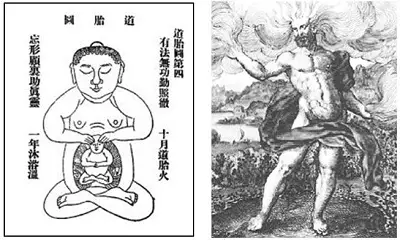
Note the embryo in the lower abdomen in both figures
Endnotes[1] https://www.goldenelixir.com/goldenelixir_press.html [2] Ingrid Fischer-Schreiber, The Shambhala Dictionary of Taoism, Page 138, Shambhala Publications, 1996. [3] Nida Chenagtsang, Karmamudra: The Yoga of Bliss: Sexuality in Tibetan Medicine and Buddhism, Sky Press, 2018. [4] Lawrence Principe, Secrets of Alchemy, University of Chicago Press, 2013. [5] April DeConick, The Gnostic New Age: How a Countercultural Spirituality Revolutionized Religion from Antiquity to Today, Columbia University Press, 2016. [6] See Louise Schleiner, "Kelly, Sir Edward (1555—1597/8)," Oxford Dictionary of National Biography, Oxford University Press, 2004. [7] John Chambers, The Metaphysical World of Isaac Newton, Destiny Books, 2018. [8] Anna Andreeva & Dominic Steavu, eds. Transforming the Void: Embryological Discourse and Reproductive Imagery in East Asian Religions, Sir Henry Wellcome Asian Series, Brill, 2016. [9] Elaine Pagels, Adam and Eve and the Serpent: Sex and Politics in Early Christianity, Page 62, Vintage, 1988.
|